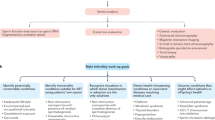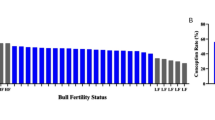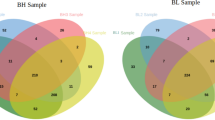Abstract
The occurrence in mammalian testes and aqueous extracts of spermatozoa of a substance causing increased spread of fluids injected intradermally was described by Hoffman and Duran-Reynals1, and McClean2. These observations have since been confirmed by numerous workers3, and the ‘spreading factor’ has been shown to be identical with the enzyme hyaluronidase first described by Meyer, Dubos and Smythe4. The work of McClean and Rowlands5, Fekete and Duran-Reynals6, and others has indicated the probable role of seminal hyaluronidase in the fertilization process, namely, solution of the gel cementing the follicle cells around freshly ovulated ova, thereby denuding the latter and so enabling spermatozoa to penetrate them. In human semen, a close correlation has been shown to exist between sperm density and hyaluronidase content, azoo-spermic semen being devoid of the enzyme7,8,9. It has also been shown that a similar relationship holds in the case of the bull, rabbit and boar, though not in the dog or fowl9; in the dog, the hyaluronidase content of semen was found to be small and seemed to vary independently of the sperm density, while in the fowl it was absent altogether from six out of ten samples tested and appeared to be present in the remainder in trivial amounts only.
This is a preview of subscription content, access via your institution
Access options
Subscribe to this journal
Receive 51 print issues and online access
$199.00 per year
only $3.90 per issue
Buy this article
- Purchase on SpringerLink
- Instant access to full article PDF
Prices may be subject to local taxes which are calculated during checkout
Similar content being viewed by others
References
Huffman, D. C., and Duran-Reynals, F., J. Exp. Med., 53, 387 (1931).
McClean, D., J. Path. Bact., 33, 1045 (1930); J. Path. Bact., 34, 459 (1931).
Chain, E., and Duthie, E. S., Brit. J. Exp. Path., 21, 324 (1940). Humphrey, J. H., Biochem. J., 37, 177 (1943). McClean, D., Biochem. J., 37, 169 (1943).
Meyer, K., Dubos, R., and Smythe, E. M., J. Biol Chem., 118, 71 (1937).
McClean, D., and Rowlands, I. W., Nature, 150, 627 (1942).
Fekete, E., and Duran-Reynals, F., J. Exp. Med., 53, 387 (1931).
Joël, C. A., and Eichenberger, E., Schweiz. med. Wschr., 27, 601 (1945).
Werthessen, N. T., Berman, S., Greenberg, B. E., and Gargill, S. L., J. Urol, 54, 565 (1945).
Swyer, G. I. M., Biochem. J., in the press.
Swyer, G. I. M., and Emmens, C. W., Biochem. J., 41, 29 (1947).
Author information
Authors and Affiliations
Rights and permissions
About this article
Cite this article
SWYER, G. Absence of Hyaluronidase from Reptilian Testes. Nature 160, 433 (1947). https://doi.org/10.1038/160433a0
Issue date:
DOI: https://doi.org/10.1038/160433a0
This article is cited by
-
Wirkstoffe der tierischen Befruchtung
Experientia (1949)



